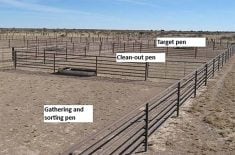SAN ANTONIO, Texas – Cattle producers can do everything right with genetics but still change outcomes dramatically with the wrong management.
Rick Funston, a reproductive physiologist with the University of Nebraska, says good management starts with matching a cow’s nutrient requirements to available feed.
Reproduction will be compromised if producers don’t do this, he told a two day seminar on cow reproduction held during the recent National Cattlemen’s Beef Association convention in San Antonio.
“We think if we feed an animal too much we are going to have dystocia problems,” Funston said.
Read Also

University of Saskatchewan experts helping ‘herders’ in Mongolia
The Canadian government and the University of Saskatchewan are part of a $10 million project trying to help Mongolian farmers modernize their practices.
That is not true, he added.
Scientists have examined a variety of nutrients to see if some affect calving ease.
Studies found that cows on winter range receiving supplements had higher weights than those not supplemented. They also got pregnant easier.
“Those cows that were (protein) supplemented in late gestation actually conceived earlier,” Funston said.
Researchers also found that a pregnant cow’s diet significantly affects the offspring’s later performance.
Steers from supplemented cows had heavier carcass weights and more achieved the top grades.
Cows may also need minerals 45 days before calving to improve calves’ immune status, but minerals require a complex balance because some can act against each other. For example, sulfates can tie up copper and zinc.
Producers should also find out what minerals are already in the feed and water because these too could be antagonistic.
A cow’s nutrient requirements are not that high, but post partum females need to gain weight. Funston said thin cows have a delayed return to estrus.
“Those animals that conceive early and calve early are going to have offspring that are going to be more valuable at weaning and at harvest. Those cows are going to have a better chance to breed back if they calve early.”
Balanced nutrition is the key to optimizing production.
“I would much rather breed a thin cow on an increasing plane of nutrition than a fat cow going the other way,” he said.
A lactating cow needs 11 percent protein, with energy intake dropping if protein falls below seven percent. Digestibility also decreases, and the cow won’t be able to eat enough forage to meet its maintenance requirements.
However, feeding too much protein may lower conception rates.
A study found lower conception rates among heifers that grazed recently fertilized pastures.
Some producers add fat to their cows’ diets for added energy and cold tolerance, but well managed cows did not show any discernible reproductive benefit. This practice may help if reproductive rates are poor, but other problems are probably occurring at the same time.
Fats such as tallow, corn, canola and soybeans have different fatty acid profiles with varying effects on reproduction and hormone release.
For example, feeding full, raw soybeans has a benefit because the beans contain estrogen. High linoleum acid from safflowers has a negative effect on reproduction because it is a precursor to prostaglandin, which can be toxic to the embryo.
Also, some cool season grasses are high in fat and mask any benefit of added fats.
Funston advised producers to price fat supplements against other protein and energy sources. They should also keep in mind that protein levels will be high because most fat supplements come from oilseed extraction.
Studies of the effects of fat and protein in dried distillers grain found a positive effect on reproduction as long as the bypass protein was balanced. Several hormones that positively influence reproduction can be diminished if the cattle receive too much bypass protein.
Heifers did well on rations that included four to five pounds of distillers grain that was balanced for crude protein and fat levels.
“Those heifers fed distillers actually had a very high AI conception rate,” Funston said.















